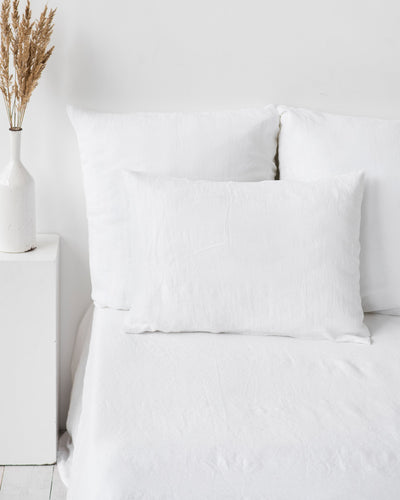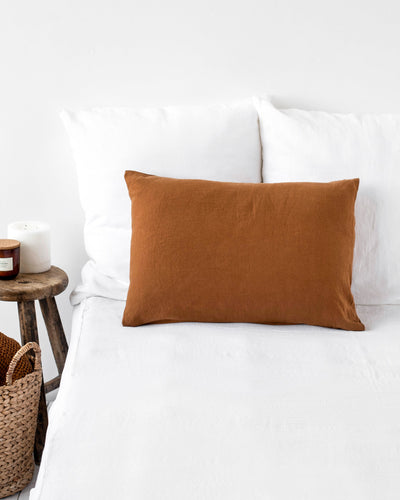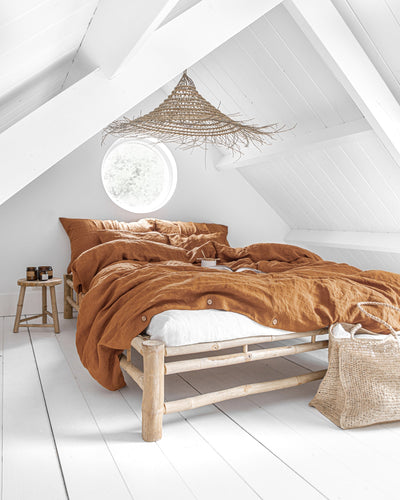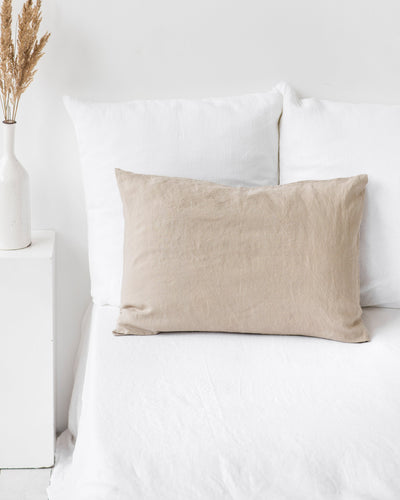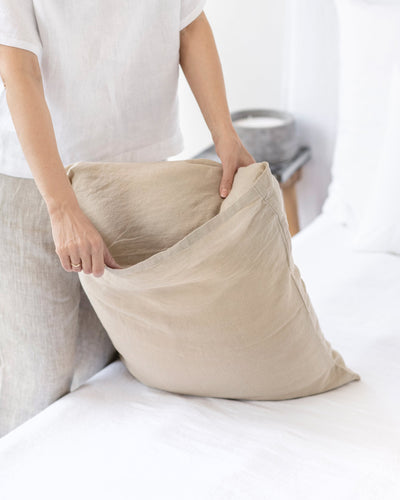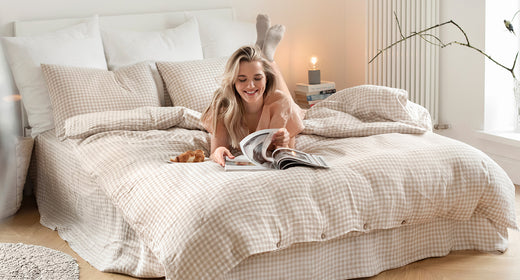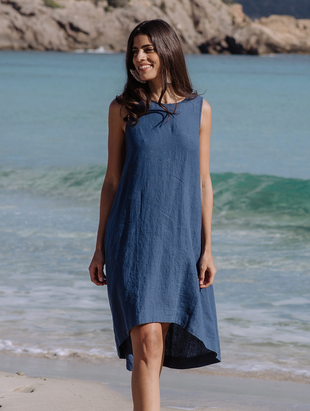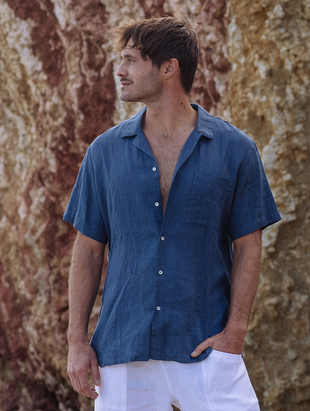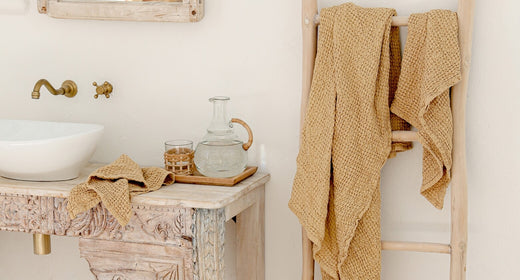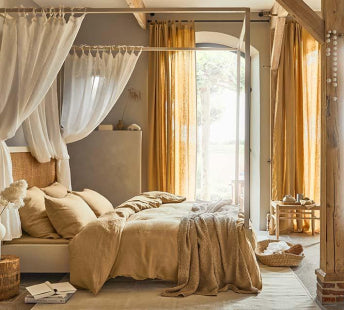Is Linen Sustainable? Facts Behind the Fabric

Key Takeaways
-
Linen requires significantly less water and pesticides than cotton, often relying solely on rainwater.
-
The entire flax plant is used in linen production, creating a zero-waste manufacturing process.
-
Quality linen pieces last for decades and become softer with age, reducing replacement needs.
-
Certifications like OEKO-TEX® help you identify truly sustainable linen products.
-
Proper care extends linen's lifespan, maximizing its environmental benefits.
You're standing in your favorite boutique, running your fingers across a beautifully woven linen dress. It feels substantial yet breathable, with that relaxed elegance you love. But as you consider adding it to your wardrobe, a question surfaces: Is linen sustainable? With growing awareness around fashion's environmental impact, it's only natural to wonder whether this beloved natural fiber aligns with your values.
The short answer is encouraging. Linen, made from the flax plant, stands out as one of the most environmentally responsible fabric choices available today. From its minimal water requirements to its complete biodegradability, linen offers a compelling case for conscious consumers seeking both style and sustainability.
Is Linen Sustainable?
Yes, linen is widely considered one of the most sustainable fabrics available. The flax plant from which linen is made grows efficiently with minimal environmental impact, requiring little water and few pesticides compared to other fiber crops. What makes linen particularly appealing from an environmental standpoint is its complete biodegradability and exceptional durability.
Unlike synthetic fabrics that shed microplastics and persist in landfills for decades, 100% linen decomposes naturally within weeks when untreated. The production process, especially when following traditional methods, avoids harsh chemicals and makes use of the entire plant. When you choose quality linen pieces, you're investing in items that can last for decades while maintaining their beauty and comfort.
The sustainability of linen does depend on responsible production practices. European-grown flax typically adheres to higher environmental standards and benefits from ideal growing conditions that require minimal intervention.
The Linen Production Process
Understanding how linen is made reveals why it's such an environmentally sound choice. The process begins with flax plants, which grow tall and straight in temperate climates. After harvesting, the flax undergoes retting—a natural process where moisture breaks down the plant's outer layer to reveal the strong fibers within.
Traditional retting uses natural rainfall and dew, requiring no additional water or chemicals. The freed fibers are then spun into yarn and woven into fabric using methods that have remained largely unchanged for centuries. This time-tested process avoids the heavy chemical treatments common in other textile production.
Modern sustainable linen production maintains these gentle methods while incorporating quality controls and certifications. When done responsibly, the entire process from field to fabric minimizes environmental impact while creating a textile that's both beautiful and durable.
Linen vs. Other Fabrics

When comparing linen to other popular textiles, its environmental advantages become clear. Cotton, while natural, requires more than 2,000 liters of water to produce a single t-shirt. In contrast, a linen shirt uses less than 7 liters across its entire lifecycle, as flax typically grows on rainfall alone.
The difference between linen and cotton extends beyond water usage. Cotton production often relies heavily on pesticides and fertilizers, while flax is naturally pest-resistant and actually improves soil health by adding organic matter.
Compared to synthetic fabrics like polyester, linen's advantages are even more pronounced. Synthetic textiles are petroleum-based and release microplastics during washing, contributing to ocean pollution. They also don't biodegrade, accumulating in landfills indefinitely. Linen's natural composition means it returns harmlessly to the earth at the end of its long life.
The durability factor is crucial here. Quality linen pieces, with proper care, can outlast most synthetic alternatives. This longevity reduces the frequency of replacement, minimizing overall consumption and waste.
The Environmental Pros of Linen
Linen's environmental benefits stem from both the flax plant's natural characteristics and the fabric's inherent qualities. The strength and longevity of linen mean fewer replacements over time, while its ability to soften and improve with age makes it a joy to own for decades.
Let's explore the specific environmental advantages that make linen such a responsible choice.
Requires minimal water and pesticides
The flax plant is remarkably resilient, thriving in poor soil conditions where other crops struggle. It typically relies entirely on natural rainfall, requiring no irrigation systems or water diversion. This rain-fed agriculture puts minimal strain on local water resources.
Flax's natural pest resistance means it needs significantly fewer pesticides and fertilizers than crops like cotton. The plant's hardy nature and relatively short growing season make it an efficient crop that works in harmony with natural ecosystems rather than disrupting them.
This efficient resource use translates to a dramatically smaller environmental footprint. While cotton production consumes thousands of liters of water per garment, linen's water usage remains minimal throughout the entire production cycle.
Fully biodegradable
When your linen pieces eventually reach the end of their long lives, they return to the earth completely and quickly. Untreated, 100% linen biodegrades within weeks in proper composting conditions, leaving no harmful residues.
This natural decomposition stands in stark contrast to synthetic fabrics, which can persist in landfills for hundreds of years. Even blended fabrics containing synthetic fibers will only partially break down, leaving synthetic components behind.
The biodegradability of linen means your clothing choices don't contribute to long-term waste accumulation, making each piece a temporary borrowing from nature rather than a permanent addition to landfills.
Durable and long-lasting

Linen is one of the strongest natural fibers available, even stronger than cotton. This inherent strength translates to garments and home textiles that withstand years of regular use while maintaining their integrity and beauty.
The unique quality of linen is that it actually improves with age and use. Each wash makes the fabric softer and more comfortable, creating pieces that you'll reach for again and again. This durability reduces the need for frequent replacements, minimizing both consumption and waste.
When you invest in quality linen pieces, you're choosing items that can serve you for decades. This longevity is perhaps the most important sustainability factor, as the environmental impact per wear becomes minimal over the fabric's extended life.
Zero-waste material
The flax plant exemplifies efficient resource use—every part serves a purpose. The long fibers become premium linen fabric, while shorter fibers are used for paper, rope, and composite materials. The woody stems become building materials, and even the seeds are pressed for linseed oil.
The flowers provide nectar for bees, supporting local ecosystems, while the plant's deep roots help prevent soil erosion and add organic matter to improve soil health. This comprehensive use means virtually nothing goes to waste in flax production.
This zero-waste approach extends to responsible manufacturers who find uses for fabric scraps and production waste, creating a circular system that maximizes every input while minimizing environmental impact.
How to Identify Truly Sustainable Linen
Not all linen is created equal, and understanding how to identify the most sustainable options helps you make choices that contribute to sustainable living and can make a meaningful difference over time.
Look for certifications
Seek out OEKO-TEX® Standard 100 or Global Organic Textile Standard (GOTS) certifications. These ensure the fabric is free from harmful substances and produced according to strict environmental and social criteria. OEKO-TEX® certification, in particular, tests for over 100 harmful substances.
Choose European linen
Flax grown in Western Europe, particularly in France, Belgium, and the Netherlands, benefits from ideal growing conditions and typically follows higher environmental standards. European linen often relies on traditional dew retting processes that require no additional water or chemicals.
Opt for natural colors
Choose undyed linen or pieces colored with natural, certified dyes. While beautiful colors are appealing, the dyeing process can introduce chemicals and increase environmental impact. Natural linen's soft, earthy tones are timeless and versatile.
Care for it properly

Extend your linen's life and environmental benefits by following proper care practices. Wash linen in cold water, line dry when possible, and embrace the natural texture that develops over time. This gentle care maintains the fabric's integrity while minimizing energy use.
Make an Informed Choice for a Greener Future
Choosing linen means supporting a textile tradition that works in harmony with natural systems while creating beautiful, long-lasting pieces for your home and wardrobe. The fabric's environmental credentials, from minimal water use to complete biodegradability, make it a responsible choice for conscious consumers.
When selecting linen pieces, consider the entire production story. Look for brands that prioritize transparency and environmental responsibility throughout their supply chain. At MagicLinen, our commitment to sustainability extends from using OEKO-TEX® certified fabrics to implementing zero-waste initiatives and biodegradable packaging.
The path from flax field to your home can embody the values of environmental stewardship and sustainability and social responsibility. Each piece you choose represents a vote for production methods that respect both people and the planet.
By choosing sustainable linen products and caring for them thoughtfully, you're participating in a more conscious approach to consumption.
Frequently Asked Questions (FAQs)
Is cotton more sustainable than linen?
Linen is generally more sustainable than cotton. While both are natural fibers, linen requires significantly less water (often relying solely on rainfall) and fewer pesticides. Cotton production typically requires thousands of liters of water per garment and heavy chemical inputs, making linen the more environmentally responsible choice.
How long does linen take to biodegrade?
Pure, untreated linen biodegrades within weeks to a few months in proper composting conditions. The exact timeline depends on factors like temperature, moisture, and soil composition, but linen breaks down much faster than cotton and infinitely faster than synthetic fabrics, which can persist for hundreds of years.
What are the environmental disadvantages of linen?
Linen's main environmental considerations include transportation impacts if grown far from manufacturing sites and potential chemical use in dyeing processes. However, these impacts are minimal compared to most other textiles.
 Österreich
Österreich
